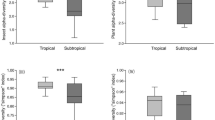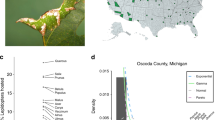Abstract
Many groups of animals show a gradient of increasing species richness from polar to equatorial regions1,2. Theory3,4 suggests that species should be more specialised ecologically in the tropics. Most of the evidence for this comes from studies on birds5–10. Birds appear to subdivide the habitat more finely and specialise more in their food in the tropics. It has been suggested11 that tropical Papilionidae (Lepidoptera) are more specialised in their hosts than temperate species, but host specificity was considered only at the level of the plant family, and more detailed studies of a wide range of butterflies12 suggest that they are little (if at all) more specialised in their food plants in the tropics. Similarly, monogenean trematode parasites of fish show no change in the degree of host specificity at different latitudes13. Here it is shown that one group of insects, the bark and ambrosia beetles (Coleoptera: Scolytidae and Platypodidae), are less host-specific in the tropics than in temperate regions, even though there are considerably more species present in the tropics. The ‘reverse’ latitudinal gradient in host specificity can be related to the greater proportion of relatively non-specific xylomycetophagous species (ambrosia beetles) in the tropics and to the greater heterogeneity of tropical forests which will make host specialisation more difficult.
This is a preview of subscription content, access via your institution
Access options
Subscribe to this journal
Receive 51 print issues and online access
$199.00 per year
only $3.90 per issue
Buy this article
- Purchase on Springer Link
- Instant access to full article PDF
Prices may be subject to local taxes which are calculated during checkout
Similar content being viewed by others
References
Fischer, A. G. Evolution 14, 64–81 (1960).
Stehli, F. G. in Evolution and Environment (ed. Drake, E.) 163–227 (Yale University Press, New Haven, 1968).
Levins, R. Evolution in Changing Environments (Princeton University Press, 1968).
MacArthur, R. H. Geographical Ecology. (Harper and Row, New York, 1972).
MacArthur, R. H., Recher, H. & Cody, M. Am. Nat. 100, 319–332 (1966).
MacArthur, R. H. Biol. J. Linn. Soc. 1, 19–30 (1969).
Cain, A. J. Biol. J. Linn. Soc. 1, 233–236 (1969).
Lack, D. Ecological Isolation in Birds. (Blackwell, Oxford, 1971).
Karr, J. R. Ecol. Mon. 41, 207–233 (1971).
Recher, H. F. Proc. Ecol. Soc. Aust. 6, 135–152 (1971).
Scriber, J. M. Psyche 80, 355–373 (1973).
Price, P. W. Evolutionary Biology of Parasites. (Princeton University Press, in the press).
Rohde, K. Mar. Biol. (in the press).
Balachowsky, A. Faune France 50, 1–320 (1949).
Bright, D. E. & Stark, R. W. Bull. Calif. Ins. Survey 16, 1–169 (1973).
Browne, F. G. Malay. For. Rec. 22, 1–255 (1961).
Beaver, R. A. & Browne, F. G. Oriental Ins. 12, 575–624 (1979).
Roberts, H. Bull. Ent. Res. 66, 373–388 (1976); J. nat. Hist. 11, 251–272, 555–578 (1977).
Schedl, K. E. Proc. 10th Int. Congr. Entomol. 1, 183–197 (1958).
Beaver, R. A. BIOTROP Spec. Publ. 2, 133–147 (1977).
Wood, S. L. Gt Basin Nat. 33, 75–90 (1973); Annls Soc. Ent. Fr. (N.S.) 14, 95–122 (1978).
Janzen, D. H. in Taxonomy and Ecology (ed. Heywood, V. H.) 201–211 (Academic, London, 1973).
Beaver, R. A. J. Anim. Ecol. 48, (in the press).
Southwood, T. R. E., May, R. M., Hassell, M. P., Conway, G. R. Am. Nat. 108, 791–804 (1974).
Pulliam, H. R. Ecology 54, 284–299 (1973).
Diamond, J. M. Proc. natn. Acad. Sci. U.S.A. 67, 1715–1721 (1970).
Beaver, R. A. Bull. Ent. Res. 65, 531–548 (1976).
Author information
Authors and Affiliations
Rights and permissions
About this article
Cite this article
Beaver, R. Host specificity of temperate and tropical animals. Nature 281, 139–141 (1979). https://doi.org/10.1038/281139a0
Received:
Accepted:
Issue Date:
DOI: https://doi.org/10.1038/281139a0
This article is cited by
-
The patterns of co-occurrence variation are explained by the low dependence of bark beetles (Coleoptera: Scolytinae and Platypodinae) on hosts along altitude gradients
Frontiers in Zoology (2022)
-
Habitat and climatic preferences drive invasions of non-native ambrosia beetles in deciduous temperate forests
Biological Invasions (2016)
-
How do generalist consumers coexist over evolutionary time? An explanation with nutrition and tradeoffs
Theoretical Ecology (2015)
-
Species diversity estimation of ambrosia and bark beetles in temperate mixed forests in Japan based on host phylogeny and specificity
Ecological Research (2014)
-
Dung beetles in an avian-dominated island ecosystem: feeding and trophic ecology
Oecologia (2014)
Comments
By submitting a comment you agree to abide by our Terms and Community Guidelines. If you find something abusive or that does not comply with our terms or guidelines please flag it as inappropriate.



